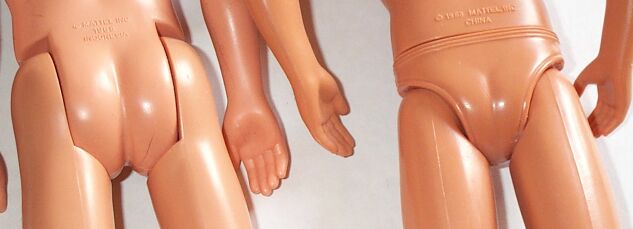![]() Keeping Ken
Keeping Ken ![]() Ask Keeping Ken Archives
Ask Keeping Ken Archives ![]() Keeping Ken Ken News!
Keeping Ken Ken News!
12-30-01
|
Please submit questions to ask@manbehindthedoll.com and have them answered here. Due to the volume of mail received, I cannot respond to individual e-mails sent to "Ask Keeping Ken". |
Q: There are two body molds
(torso and legs) used widely in Modern Ken dolls- the PTS (Point To
Side)/PTR (Point To Rear) body and the Bent Arm (BA) body. The PTS
style body came out in 1968 or 1969, so it had a date of 1968 on its
back. This continues to today. However, when Superstar Ken came out in
1977, he had an all-new body, but it still had a date of 1968. Did
Mattel invent both body styles at the same time and produce one first?
If so, why didn't they introduce the better one period?
Omar AKK: You are correct, there are two different types of body molds used for the current Ken doll line. One is used when the Ken has the bent arms, and the other is used when he has either PTR or PTS arms. It is easy to distinguish the two body mold because the bent arm mold will always have a twist waist and molded underwear. The other version with the PTR or PTS arms will have the familiar 1968 body mold. (See photo below). The legs and arms are also joined to the body mold differently like you mentioned. |
||

You are also correct in noticing that there are different versions of the 1968 body mold used, but there were many modifications to this body mold when it was first introduced. It was first introduced in a modified form for Talking Ken in 1968, then in it's true form on New Good Lookin' Ken in 1969 and modified again for Free Moving Ken in 1974. The original integrity of the body mold stayed intact, only cosmetic changes were made for enhancements for features like talking and freer movement.
If you look at other dolls during the SuperStar head mold era, you will notice that Mattel made another modification to the 1968 body mold. They now made the torso completely closed at the bottom and sides. the seams were no longer glued, but poured in one mold, not separate molds and then put (glued) together. The SuperStar Ken used this new process, but had a different neck and torso bottom for the ball joints and bent arms. Look at the example below between Sun Lovin' Malibu Ken 1978 (pictured on the left) and Malibu Ken Pink Box 1974-1976. See how the seam is now joined in the front lower portion of the stomach of the body mold? The Sun Lovin' Ken did not use the ball socket torso, so it is of course different.
You can see by another picture (below) that it is essentially the same body mold, but it is now poured together, not separately, which is why it has new markings.
Mattel did continue to use the ball jointed body for Sport & Shave Ken (1980), Western Ken (1981), All Star Ken (1982), Horse Lovin' Ken (1983), Dream Date Ken (1983) and Todd (Groom), (1983). The demise of this body mold may have to do with the creation of the 1983 Ken head mold. There were two different types of SuperStar head molds made to either fit the standard body, or the ball jointed body. Only one type of 1983 Ken head mold was made to fit the standard body. This would probably explain why you didn't see the ball jointed body mold again after this period. To ever see it again, Mattel would have to make a new head mold that would accommodate the mechanism, or modify an existing Ken head mold. |
|||